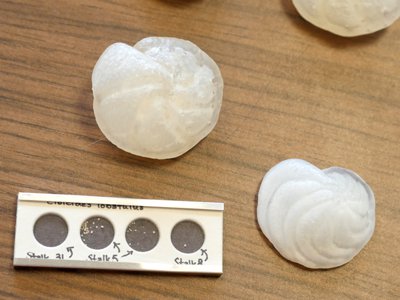Reduced Oxygen During Ice Age Sheds Light on ‘Missing’ Carbon Dioxide
Tiny ocean dwellers witnessed climate cycles, report past conditions

Climate is not constant on Earth. Consider ice ages coming and going as an example. Parallel to ice age cycles, atmospheric carbon dioxide reduces during glacial periods and increases during warmer times, although modern fossil fuel-related carbon dioxide emission broke this natural cyclicity. With the proper proxy measurements, scientists can look into these past cycles to determine how exactly climate systems were naturally governed.
Syracuse University Earth sciences Assistant Professor Zunli Lu says, “A million dollar question in understanding climate system is: Where and how was CO2 sequestered from the atmosphere during ice ages?”

Lu and international collaborators explored the question of carbon dioxide storage in the oceans. The team glimpsed into the ocean’s past, thanks to a group of tiny ocean dwellers called foraminifera. The foraminifera were preserved in sediment cores taken from an underwater mountain in the Amundsen Sea, which is part of the ocean surrounding Antarctica. Their study on the ocean records, trapped in foraminifera shells, is published in Nature Communications.
Although it is accepted that atmospheric carbon dioxide was sucked deep into the ocean during ice ages, quantitative measures of how much was stored, and in what chemical form, have been hard to come by. One way to track carbon dioxide storage is by investigating its partner in respiration: oxygen. Plankton photosynthesize near the ocean surface, taking in carbon dioxide. When the plankton die and sink to the ocean floor, the reverse process, respiration, happens. Respiration uses up oceanic oxygen and re-releases carbon dioxide in the deep ocean. Because of this relationship, low oxygen levels in a specific part of the ocean can flag where atmospheric carbon dioxide was stored during glacial periods.

While past oceanic oxygen levels can provide insight to global carbon dioxide cycling, reconstructing past oxygenation conditions is quite a challenge. Enter foraminifera. Foraminifera have an external shell made of calcium carbonate, which traps signatures of their environment as they grow—including oxygen levels. These climate-related signatures are often preserved for millions of years in sediments accumulated on the ocean floor.
Lu has spent years measuring iodine in calcium carbonate as a proxy for tracking oceanic oxygen levels. “These carbonates recorded almost the entire Earth’s history , and we have one of the best ways of translating the oxygen stories out of these rocks and fossils” he says. Unlike most other oxygen proxies, iodine is able to detect relatively subtle changes in oxygen levels, not just presence or absence of the gas in seawaters.
Study co-author Babette Hoogakker of the University of Oxford seconds the power of this new proxy: “Its application allows the assessment of open ocean subsurface oxygenation states using planktonic foraminifera, which until now was virtually impossible.”
Foraminifera from the group’s study site in the high-latitude Antarctic indicate that the surrounding Southern Ocean reached very low levels of oceanic oxygen during ice ages. Co-author Ros Rickaby, also of Oxford, says, “It was a real surprise to discover that any part of the Southern Ocean, which today is so rich in oxygen, evolved naturally to contain such small amounts of this influential gas during the glacial period.”

Co-author Claus-Dieter Hillenbrand of the British Antarctic Survey says, “Physical, chemical and biological changes in the World Ocean in general, and in the Southern Ocean in particular, played a crucial role for glacial-interglacial variations in atmospheric carbon dioxide concentrations and global climate change.”
Or as Lu puts it: “The Southern Ocean is like a tap for CO2. When you open the tap, CO2 goes into the atmosphere and it becomes warm globally. When you partially shut that valve during an ice age, CO2 becomes lower in the atmosphere.” Lu says that finding low oxygen in the high-latitude Southern Ocean gives insight into how the “valve” works during ice ages, and moreover points to the oxygenation conditions in vast volumes of deep waters connected to the Southern Ocean through ocean circulation.
Lu and colleagues hope that understanding the past cycles will give researchers foresight into the effects of modern and future global changes. While the level of atmospheric carbon dioxide routinely cycled between 200 and 280 parts per million in the past, the planet is currently faced with levels of 400 parts per million of the gas. “If we can explain the naturally oscillating recent climate, we may be able to make predictions for how modern warming might cause the marine environment to change in the future,” Lu says.
The study can be read on-line here:
http://www.nature.com/ncomms/2016/160331/ncomms11146/full/ncomms11146.html
Featured
Zunli Lu Thonis Family Professor: Low-Temperature Geochemistry and Earth System Evolution
